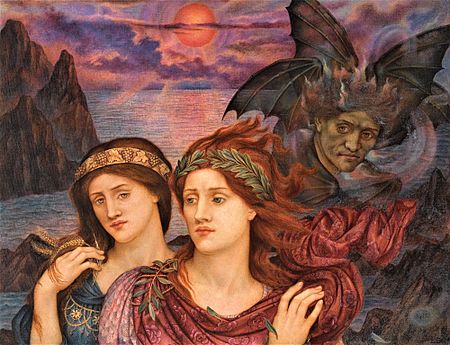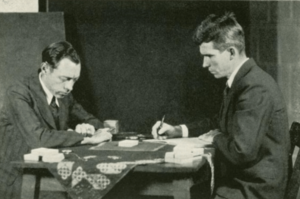Extrasensory perception facts for kids
Extrasensory perception or ESP is often called the sixth sense. It is a claimed ability to get information without using your normal five senses, like sight, hearing, touch, smell, or taste. Instead, people say this information is sensed with the mind.
The term ESP was made popular by a scientist named Joseph Banks Rhine in the 1930s. He used it to describe abilities like telepathy (knowing what someone else is thinking) and precognition (seeing the future).

Second sight is a type of ESP. It means a person might see things, like a vision, about future events before they happen. Or they might see things happening in faraway places. There is no scientific proof that second sight or ESP exist. Stories about them are just personal accounts, not scientific evidence. Scientists consider ESP and second sight to be pseudoscience, which means they are not based on scientific facts.
Contents
History of ESP Research
In the 1930s, at Duke University in North Carolina, a scientist named Joseph Banks Rhine and his wife, Louisa E. Rhine, started studying extrasensory perception. Louisa collected stories from people who said they had ESP experiences. Joseph worked in a lab, trying to test these abilities.
Zener Cards and Experiments
Joseph Rhine created a simple set of cards to test ESP. They were first called Zener cards, but now they are often called ESP cards. Each card has one of five symbols: a circle, square, wavy lines, cross, or star. A pack has 25 cards, with five of each symbol.
Here is how some experiments worked:
- Telepathy: One person, the "sender," looked at a card. Another person, the "receiver," tried to guess the symbol just by thinking about it.
- Clairvoyance: The cards were hidden from everyone. The receiver tried to guess the symbols without anyone knowing what they were.
- Precognition: The receiver guessed the order of the cards before the cards were even arranged.
Later, Rhine also used dice to test for psychokinesis, which is the idea of moving objects with your mind.
Criticism of Early ESP Studies
Many scientists did not agree with Rhine's experiments. Other psychology departments tried to repeat his tests but could not get the same results. For example, a scientist named W. S. Cox at Princeton University did a large experiment with many people. He found no evidence of ESP.

In 1938, psychologist Joseph Jastrow said that much of the evidence for ESP was just stories. He also said it came from "faulty observation" or simple human mistakes. Rhine's experiments were later questioned because of "sensory leakage." This means people might have accidentally gotten clues. For example, a person might have seen the symbols through the back of the cards. Or they might have heard small sounds or seen tiny movements from the experimenter.
Later ESP Research
In the 1960s, scientists studying ESP started looking at how people felt during these experiences. They used new methods, like dream telepathy experiments. They also used ganzfeld experiments, which involve mild sensory deprivation. This means reducing sights and sounds to help people focus.
What is "Second Sight"?
The term "second sight" might have come from the idea that normal vision is "first sight." So, supernormal vision, which only some people claim to have, would be "second sight." In Scottish Gaelic, people say an dà shealladh, which means "the two sights." This refers to the ability to see the future or distant events without trying.
Why Scientists Are Skeptical
Parapsychology is the study of paranormal psychic events, including ESP. However, scientists have criticized this field. After more than a hundred years of research, parapsychology has not found strong evidence for any psychic abilities.
The scientific community does not believe ESP is a real scientific phenomenon. This is because there is no proof that it exists. Also, there is no scientific theory to explain how ESP would work. Scientists consider ESP to be a pseudoscience.
Problems with ESP Experiments
Scientists who are skeptical point out that there are many problems with how ESP experiments are designed. These problems are found in many studies that claim to show ESP.
- Getting Clues: Sometimes, people in ESP tests might get clues without even knowing it. This is called "sensory leakage." For example, a person might see a reflection of a Zener card in the experimenter's glasses. Or the cards might have tiny marks on them. If someone sees these clues, they can guess correctly without using ESP.
- Bad Shuffling: If cards are not shuffled well, their order might be easier to guess. This is called "poor randomization." It means the results are not truly random.
- Counting Errors: In some studies, the way results were counted could lead to mistakes. This could make it seem like ESP was happening when it was not.
When these problems are fixed, studies usually find no significant evidence for ESP. Many studies that seemed to show ESP had these kinds of errors.
Dermo-optical Perception
In the early 1900s, a man named Joaquin María Argamasilla from Spain claimed to have "X-ray Eyes." He said he could read writing or numbers on dice inside closed metal boxes. He even fooled some scientists into thinking he had real psychic powers.
However, in 1924, the famous magician Harry Houdini showed that Argamasilla was a fraud. Argamasilla simply peeked through his blindfold. He also lifted the edge of the box slightly so he could see inside without others noticing.
Science writer Martin Gardner has explained that many people investigating "second sight" did not know about these simple magic tricks. He showed how psychics like Rosa Kuleshova and Nina Kulagina used similar tricks to peek from their blindfolds. This made it seem like they had special powers when they were just cheating.
See also
 In Spanish: Percepción extrasensorial para niños
In Spanish: Percepción extrasensorial para niños
- Extrasensory Perception (book)
- Inner eye
- List of psychic abilities
- List of topics characterized as pseudoscience
- Magic
- Outline of parapsychology


